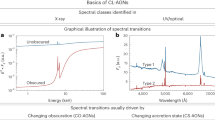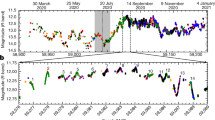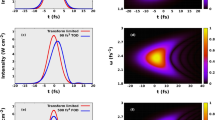Abstract
BL Lacertids are a class of active galactic nuclei (AGNs) characterized in part by flat radio spectra and rapid flux variability on time scales of weeks to days, at centimetre to optical wavelengths1. One such object, OJ 287, exhibits very short time-scale (minutes) nonperiodic variations in infrared and centimetre flux, as well as in optical polarization2–4. Over the past fifteen years, there have also been reports of short term (tens of minutes) periodic5 – 8 modulation of the emission from OJ287 at a variety of wavelengths; these periodicities have proved elusive to confirm3,9, perhaps because they are inherently sporadic. Because the presence of periodic flux variations strongly constrains the nature of the central source within an AGN, the report of periodic variability in OJ287 with a stable 15.7-min period detected at multiple frequencies and using different telescopes8, prompted us to under-take observations of this object at 7-mm wavelength. In this letter, we report detection in February 1986 of a weak (4% amplitude), 35-min flux modulation of OJ 287, whose statistical significance we estimate to be ∼97%. Nearly one year later, observations of the same source revealed no periodicities between 4 and 300 min with amplitudes greater than 2%.
This is a preview of subscription content, access via your institution
Access options
Subscribe to this journal
Receive 51 print issues and online access
$199.00 per year
only $3.90 per issue
Buy this article
- Purchase on SpringerLink
- Instant access to full article PDF
Prices may be subject to local taxes which are calculated during checkout
Similar content being viewed by others
References
Wiita, P. J. Phys. Rep. 123, 117–213 (1985).
Wolstencroft, R. D., Gilmore, G. & Williams, P. M. Mon. Not. R. astr. Soc. 201, 479–485 (1982).
Dreher, J. W., Roberts, D. H. & Lehar, J. Nature 320, 239–242 (1986).
Kulshrestha, A. K., Joshi, U. C. & Deshpande, M. R. Nature 311, 733–734 (1984).
Visvanathan, N. & Elliot, J. L. Astrophys. J. 179, 721–730 (1973).
Frolich, A., Goldsmith, S. & Weistrop, D. Mon. Not. R. astr. Soc. 168, 417–425 (1974).
Carrasco, L., Dultzin-Hacyan, D. & Cruz-Gonzalez, I. Nature 314, 146–148 (1985).
Valtaoja, E. et al. Nature 314, 148–149 (1985).
Kiplinger, A. J. Astrophys. J. 191, L109–L110 (1974).
Predmore, C. R. Five College Radio Astronomy Observatory Report No. 310 (1987).
Penzias, A. A. & Burrus, C. A. A. Rev. Astr. Astrophys. 11, 51–72 (1973).
Deeming, T. J. Astrophys. Space Sci. 36, 137–158 (1975).
Scargle, J. D. Astrophys. J. 263, 835–853 (1982).
Horne, J. H. & Baliunas, S. L. Astrophys. J. 302, 757–763 (1986).
Jurkevich, I. Astrophys. Space Sci. 13, 154–167 (1971).
Sunyaev, R. A. Sov. Astr. 16, 941–943 (1973).
Elliot, J. L. & Shapiro, S. L. Astrophys. J. 192, L3–L6 (1974).
Abramowicz, M. A. & Nobili, L. Nature 300, 506–508 (1982).
Author information
Authors and Affiliations
Rights and permissions
About this article
Cite this article
Kinzel, W., Dickman, R. & Predmore, C. A possible 35-minute periodicity in the OJ 287 active galactic nucleus at 7-mm wavelength. Nature 331, 48–50 (1988). https://doi.org/10.1038/331048a0
Received:
Accepted:
Issue date:
DOI: https://doi.org/10.1038/331048a0
This article is cited by
-
Study of Rapid Variability of the Blazar OJ 287 in the Radio and Optical Ranges
Astrophysics (2020)
-
On the variability timescales and magnetic field in OJ 287
Astrophysics and Space Science (1996)
-
The rise and fall of OJ 287 in 1983?1984: Periodicities and wavelength-dependent delays
Astrophysics and Space Science (1991)
-
A possible nineteen-minute periodicity in the light curve of OJ 287
Astrophysics and Space Science (1990)



